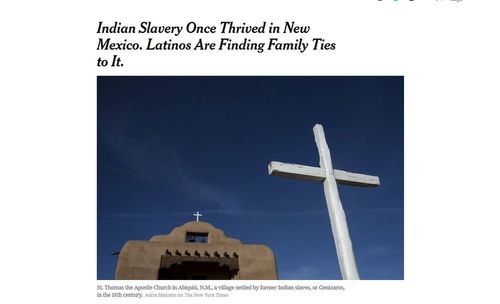“I didn’t know about New Mexico’s slave trade, so I was just stunned,” said Mr. Trujillo, 66, a retired postal worker who lives in Los Angeles. “Then I discovered how slavery was a defining feature of my family’s history.”
Mr. Trujillo is one of many Latinos who are finding ancestral connections to a flourishing slave trade on the blood-soaked frontier now known as the American Southwest. Their captive forebears were Native Americans — slaves frequently known as Genízaros (pronounced heh-NEE-sah-ros) who were sold to Hispanic families when the region was under Spanish control from the 16th to 19th centuries. Many Indian slaves remained in bondage when Mexico and later the United States governed New Mexico.
The revelations have prompted some painful personal reckonings over identity and heritage. But they have also fueled a larger, politically charged debate on what it means to be Hispanic and Native American.
A growing number of Latinos who have made such discoveries are embracing their indigenous backgrounds, challenging a long tradition in New Mexico in which families prize Spanish ancestry. Some are starting to identify as Genízaros. Historians estimate that Genízaros accounted for as much as one-third of New Mexico’s population of 29,000 in the late 18th century.
“We’re discovering things that complicate the hell out of our history, demanding that we reject the myths we’ve been taught,” said Gregorio Gonzáles, 29, an anthropologist and self-described Genízaro who writes about the legacies of Indian enslavement.
Those legacies were born of a tortuous story of colonial conquest and forced assimilation.
New Mexico, which had the largest number of sedentary Indians north of central Mexico, emerged as a coveted domain for slavers almost as soon as the Spanish began settling here in the 16th century, according to Andrés Reséndez, a historian who details the trade in his 2016 book, “The Other Slavery.” Colonists initially took local Pueblo Indians as slaves, leading to an uprising in 1680 that temporarily pushed the Spanish out of New Mexico.
The trade then evolved to include not just Hispanic traffickers but horse-mounted Comanche and Ute warriors, who raided the settlements of Apache, Kiowa, Jumano, Pawnee and other peoples. They took captives, many of them children plucked from their homes, and sold them at auctions in village plazas.
The Spanish crown tried to prohibit slavery in its colonies, but traffickers often circumvented the ban by labeling their captives in parish records as criados, or servants. The trade endured even decades after the Mexican-American War, when the United States took control of much of the Southwest in the 1840s.
Seeking to strengthen the 13th Amendment, which abolished slavery in 1865, Congress passed the Peonage Act of 1867 after learning of propertied New Mexicans owning hundreds and perhaps thousands of Indian slaves, mainly Navajo women and children. But scholars say the measure, which specifically targeted New Mexico, did little for many slaves in the territory.
Many Hispanic families in New Mexico have long known that they had indigenous ancestry, even though some here still call themselves “Spanish” to emphasize their Iberian ties and to differentiate themselves from the state’s 23 federally recognized tribes, as well as from Mexican and other Latin American immigrants.
But genetic testing is offering a glimpse into a more complex story. The DNA of Hispanic people from New Mexico is often in the range of 30 to 40 percent Native American, according to Miguel A. Tórrez, 42, a research technologist at Los Alamos National Laboratory and one of New Mexico’s most prominent genealogists. …
Pointing to their history, some descendants of Genízaros are coming together to argue that they deserve the same recognition as Native tribes in the United States. One such group in Colorado, the 200-member Genízaro Affiliated Nations, organizes annual dances to commemorate their heritage.
“It’s not about blood quantum or DNA testing for us, since those things can be inaccurate measuring sticks,” said David Atekpatzin Young, 62, the organization’s tribal chairman, who traces his ancestry to Apache and Pueblo peoples. “We know who we are, and what we want is sovereignty and our land back.”













